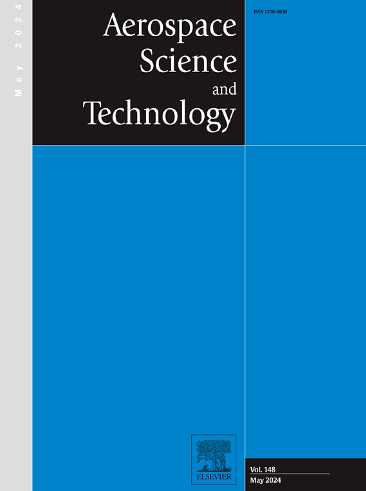Thermo-chemical non-equilibrium flows and aerodynamic loads of Type III shock/shock interaction on blunted lip of a Mach 12 inlet
IF 5
1区 工程技术
Q1 ENGINEERING, AEROSPACE
引用次数: 0
Abstract
The aerothermal challenges are often accentuated by shock/shock interactions (SSI) in the hypervelocity flow. Due to the small scale, the blunted inlet lip is likely to encounter an extremely harsh thermal environment among the components of an airbreathing vehicle. In the present study, an open-source solver named hy2Foam is used to obtain the unexplored flow characteristics of small-scale Type IIIa SSI at Mach 12 with incident shock angle of , and . The transition from Type III to Type IV SSI is observed with the increase of dimensionless intercept . Different from the results in the previous study, the shear layer in Type IIIa SSI doesn't directly attach but deflects twice before the final attachment. This phenomenon stems from the coupling between the shear layer attachment process and the shock wave/shear layer interaction. As increases, the Mach reflection (MR) within Type IIIa SSI can transform to regular reflection (RR) owing to the decrease of the first deflection angle of shear layer, and the flows remain steady during the transition process from Type IIIa SSI to Type IV SSI. The flow within a valley region between the shear layer and the cylinder surface is the closest to thermal equilibrium and chemical equilibrium in the whole flow field. Due to the strong recompression shock generated by the final attachment of the shear layer, the peak of pressure and heat transfer at the critical state transitioning from Type IIIa to Type IV SSI is the highest for Type IIIa SSI, achieving 30.8 and 40.08 times to the stagnation values in undisturbed flow, respectively. Finally, a new power-law correlation between pressure and heat transfer intensifications for Type III SSI on the blunted lip of a Mach 12 inlet is obtained. Those insights in this research are poised to provide a reference for the thermal protection design of high Mach number inlets.
12马赫进气道钝唇上III型激波/激波相互作用的热化学非平衡流动和气动载荷
在超高速流动中,激波/激波相互作用(SSI)往往加剧了气动热挑战。由于规模小,钝化的进气唇可能会遇到一个极其恶劣的热环境在一个吸气式车辆的组件。在本研究中,使用开源求解器hy2Foam计算了12马赫入射激波角β为12、15和18°时小型IIIa型SSI未探测的流动特性。随着无量纲截距Ir的增加,观察到从III型向IV型SSI的转变。与以往研究结果不同的是,IIIa型SSI的剪切层并不直接附着,而是在最终附着之前发生了两次偏转。这种现象源于剪切层附着过程与激波/剪切层相互作用的耦合。随着Ir的增加,由于剪切层第一次偏转角的减小,IIIa型SSI内的马赫反射(MR)可以转变为规则反射(RR),并且在IIIa型SSI向IV型SSI过渡的过程中流动保持稳定。在整个流场中,剪切层与圆柱表面之间的山谷区域内的流动最接近热平衡和化学平衡。由于剪切层最终附着产生强烈的再压缩激波,在IIIa型SSI向IV型SSI过渡临界状态时,压力和换热峰值最高,分别达到无扰动流动滞止值的30.8倍和40.08倍。最后,在马赫数为12的进气道钝唇处,得到了III型SSI的压力和传热强度之间新的幂律关系。这些研究成果将为高马赫数进气道热防护设计提供参考。
本文章由计算机程序翻译,如有差异,请以英文原文为准。
求助全文
约1分钟内获得全文
求助全文
来源期刊

Aerospace Science and Technology
工程技术-工程:宇航
CiteScore
10.30
自引率
28.60%
发文量
654
审稿时长
54 days
期刊介绍:
Aerospace Science and Technology publishes articles of outstanding scientific quality. Each article is reviewed by two referees. The journal welcomes papers from a wide range of countries. This journal publishes original papers, review articles and short communications related to all fields of aerospace research, fundamental and applied, potential applications of which are clearly related to:
• The design and the manufacture of aircraft, helicopters, missiles, launchers and satellites
• The control of their environment
• The study of various systems they are involved in, as supports or as targets.
Authors are invited to submit papers on new advances in the following topics to aerospace applications:
• Fluid dynamics
• Energetics and propulsion
• Materials and structures
• Flight mechanics
• Navigation, guidance and control
• Acoustics
• Optics
• Electromagnetism and radar
• Signal and image processing
• Information processing
• Data fusion
• Decision aid
• Human behaviour
• Robotics and intelligent systems
• Complex system engineering.
Etc.
 求助内容:
求助内容: 应助结果提醒方式:
应助结果提醒方式:


